人教版高中必修4英语Unit 1 Women of achievement reading 教案
文档属性
| 名称 | 人教版高中必修4英语Unit 1 Women of achievement reading 教案 | 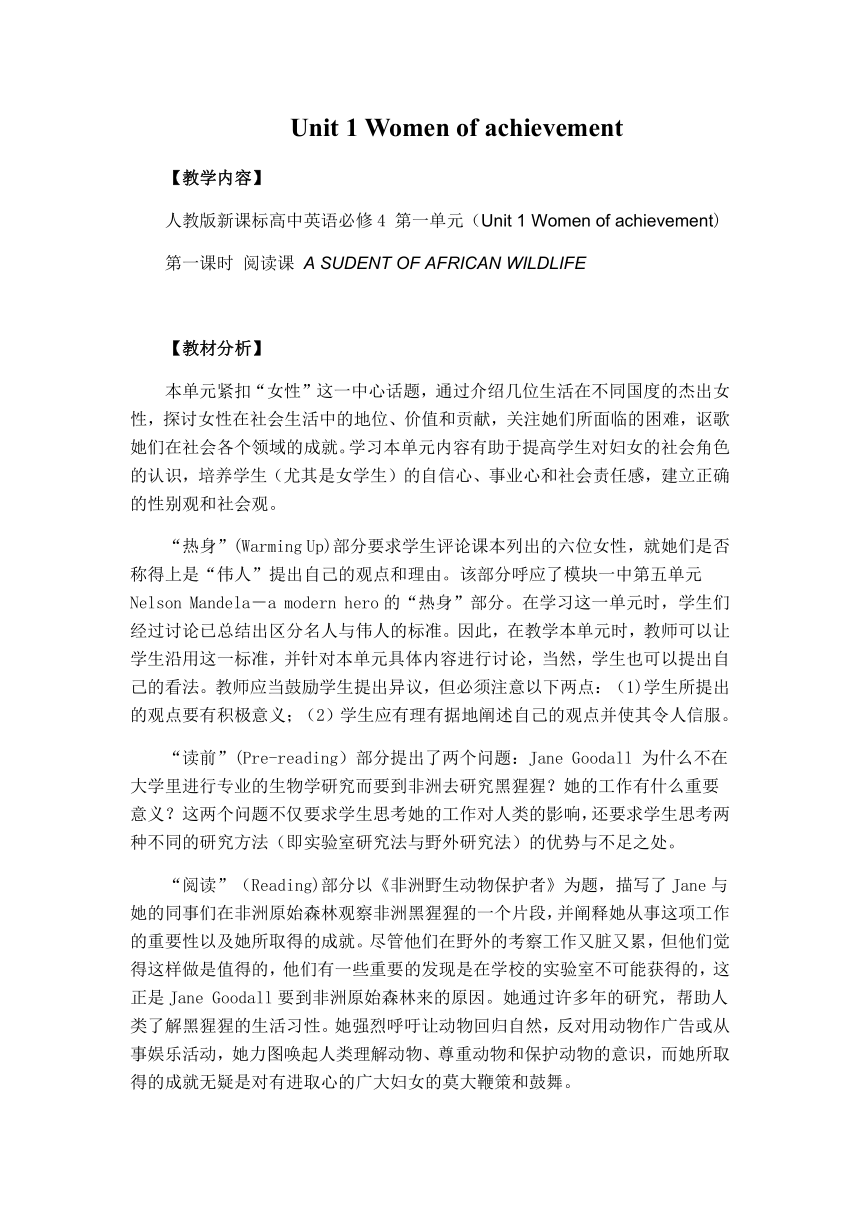 | |
| 格式 | zip | ||
| 文件大小 | 42.5KB | ||
| 资源类型 | 教案 | ||
| 版本资源 | 人教版(新课程标准) | ||
| 科目 | 英语 | ||
| 更新时间 | 2020-05-26 19:41:53 | ||
图片预览

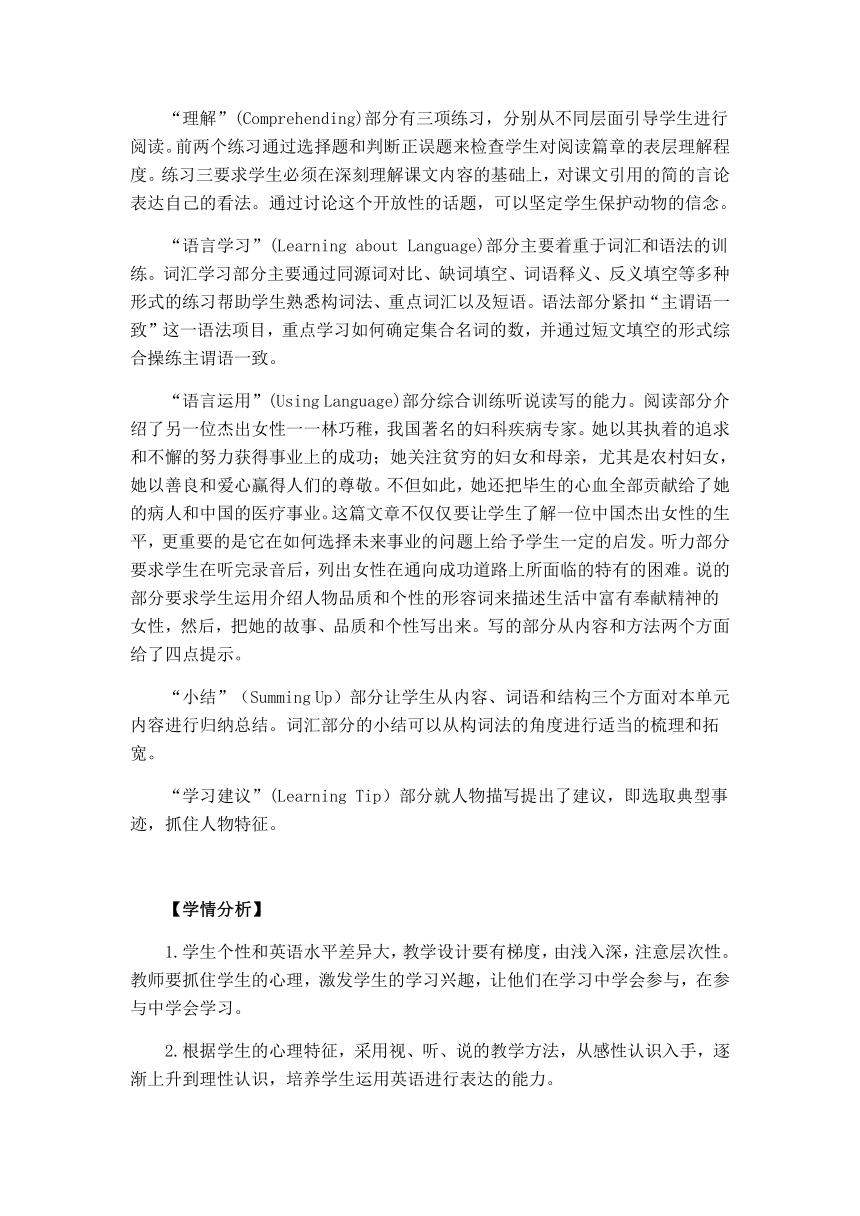
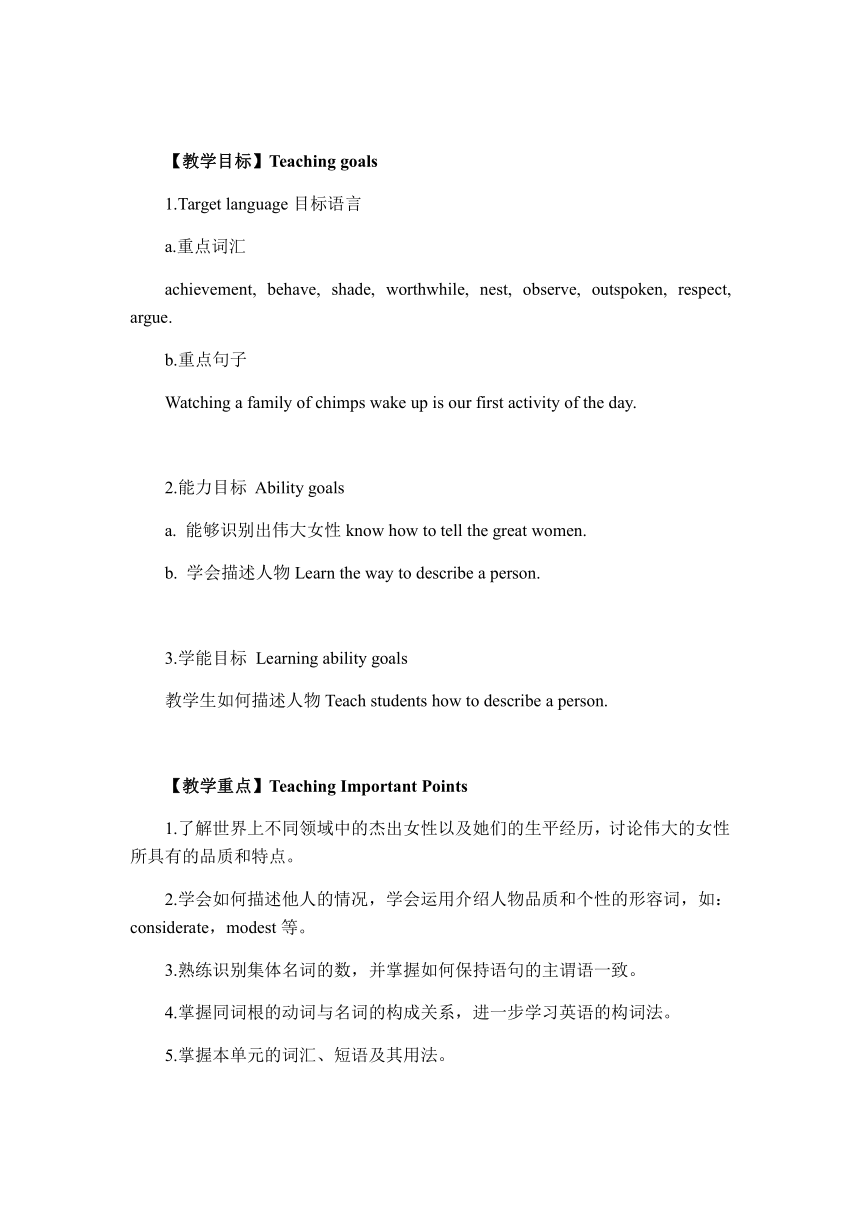
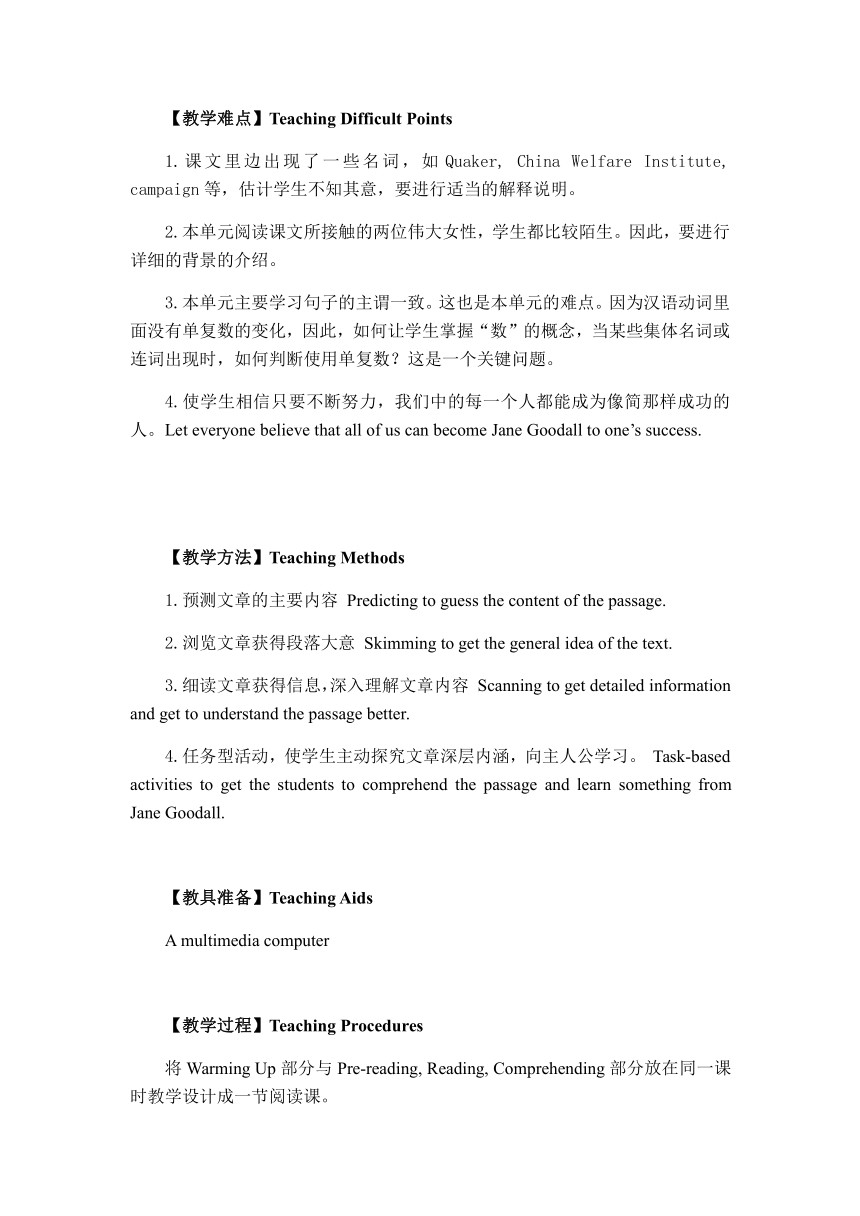
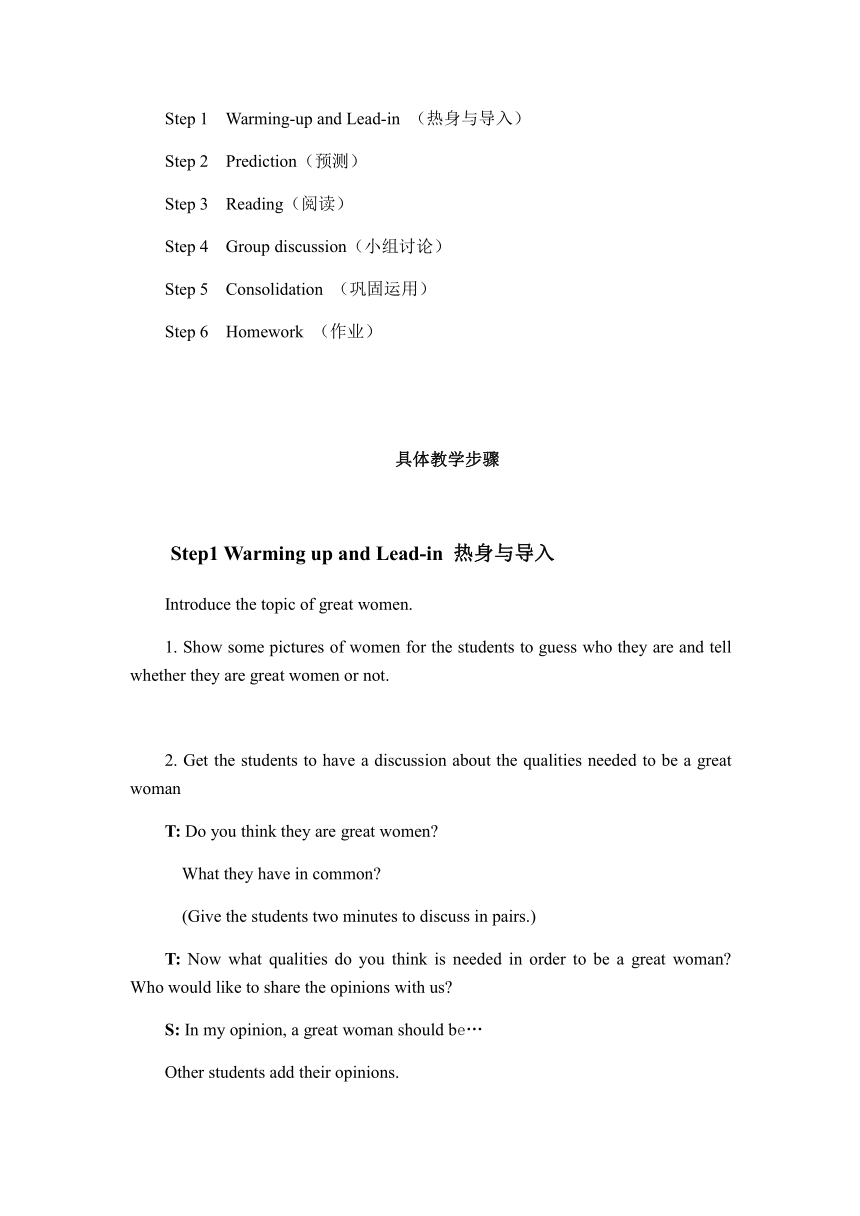
文档简介
Unit
1
Women
of
achievement
【教学内容】
人教版新课标高中英语必修4
第一单元(Unit
1
Women
of
achievement)
第一课时
阅读课
A
SUDENT
OF
AFRICAN
WILDLIFE
【教材分析】
本单元紧扣“女性”这一中心话题,通过介绍几位生活在不同国度的杰出女性,探讨女性在社会生活中的地位、价值和贡献,关注她们所面临的困难,讴歌她们在社会各个领域的成就。学习本单元内容有助于提高学生对妇女的社会角色的认识,培养学生(尤其是女学生)的自信心、事业心和社会责任感,建立正确的性别观和社会观。
“热身”(Warming
Up)部分要求学生评论课本列出的六位女性,就她们是否称得上是“伟人”提出自己的观点和理由。该部分呼应了模块一中第五单元Nelson
Mandela-a
modern
hero的“热身”部分。在学习这一单元时,学生们经过讨论已总结出区分名人与伟人的标准。因此,在教学本单元时,教师可以让学生沿用这一标准,并针对本单元具体内容进行讨论,当然,学生也可以提出自己的看法。教师应当鼓励学生提出异议,但必须注意以下两点:(1)学生所提出的观点要有积极意义;(2)学生应有理有据地阐述自己的观点并使其令人信服。
“读前”(Pre-reading)部分提出了两个问题:Jane
Goodall
为什么不在大学里进行专业的生物学研究而要到非洲去研究黑猩猩?她的工作有什么重要意义?这两个问题不仅要求学生思考她的工作对人类的影响,还要求学生思考两种不同的研究方法(即实验室研究法与野外研究法)的优势与不足之处。
“阅读”(Reading)部分以《非洲野生动物保护者》为题,描写了Jane与她的同事们在非洲原始森林观察非洲黑猩猩的一个片段,并阐释她从事这项工作的重要性以及她所取得的成就。尽管他们在野外的考察工作又脏又累,但他们觉得这样做是值得的,他们有一些重要的发现是在学校的实验室不可能获得的,这正是Jane
Goodall要到非洲原始森林来的原因。她通过许多年的研究,帮助人类了解黑猩猩的生活习性。她强烈呼吁让动物回归自然,反对用动物作广告或从事娱乐活动,她力图唤起人类理解动物、尊重动物和保护动物的意识,而她所取得的成就无疑是对有进取心的广大妇女的莫大鞭策和鼓舞。
“理解”(Comprehending)部分有三项练习,分别从不同层面引导学生进行阅读。前两个练习通过选择题和判断正误题来检查学生对阅读篇章的表层理解程度。练习三要求学生必须在深刻理解课文内容的基础上,对课文引用的简的言论表达自己的看法。通过讨论这个开放性的话题,可以坚定学生保护动物的信念。
“语言学习”(Learning
about
Language)部分主要着重于词汇和语法的训练。词汇学习部分主要通过同源词对比、缺词填空、词语释义、反义填空等多种形式的练习帮助学生熟悉构词法、重点词汇以及短语。语法部分紧扣“主谓语一致”这一语法项目,重点学习如何确定集合名词的数,并通过短文填空的形式综合操练主谓语一致。
“语言运用”(Using
Language)部分综合训练听说读写的能力。阅读部分介绍了另一位杰出女性一一林巧稚,我国著名的妇科疾病专家。她以其执着的追求和不懈的努力获得事业上的成功;她关注贫穷的妇女和母亲,尤其是农村妇女,她以善良和爱心赢得人们的尊敬。不但如此,她还把毕生的心血全部贡献给了她的病人和中国的医疗事业。这篇文章不仅仅要让学生了解一位中国杰出女性的生平,更重要的是它在如何选择未来事业的问题上给予学生一定的启发。听力部分要求学生在听完录音后,列出女性在通向成功道路上所面临的特有的困难。说的部分要求学生运用介绍人物品质和个性的形容词来描述生活中富有奉献精神的女性,然后,把她的故事、品质和个性写出来。写的部分从内容和方法两个方面给了四点提示。
“小结”(Summing
Up)部分让学生从内容、词语和结构三个方面对本单元内容进行归纳总结。词汇部分的小结可以从构词法的角度进行适当的梳理和拓宽。
“学习建议”(Learning
Tip)部分就人物描写提出了建议,即选取典型事迹,抓住人物特征。
【学情分析】
1.学生个性和英语水平差异大,教学设计要有梯度,由浅入深,注意层次性。教师要抓住学生的心理,激发学生的学习兴趣,让他们在学习中学会参与,在参与中学会学习。
2.根据学生的心理特征,采用视、听、说的教学方法,从感性认识入手,逐渐上升到理性认识,培养学生运用英语进行表达的能力。
【教学目标】Teaching
goals
1.Target
language目标语言
a.重点词汇
achievement,
behave,
shade,
worthwhile,
nest,
observe,
outspoken,
respect,
argue.
b.重点句子
Watching
a
family
of
chimps
wake
up
is
our
first
activity
of
the
day.
2.能力目标
Ability
goals
a.
能够识别出伟大女性know
how
to
tell
the
great
women.
b.
学会描述人物Learn
the
way
to
describe
a
person.
3.学能目标
Learning
ability
goals
教学生如何描述人物Teach
students
how
to
describe
a
person.
【教学重点】Teaching
Important
Points?
1.了解世界上不同领域中的杰出女性以及她们的生平经历,讨论伟大的女性所具有的品质和特点。
2.学会如何描述他人的情况,学会运用介绍人物品质和个性的形容词,如:considerate,modest等。
3.熟练识别集体名词的数,并掌握如何保持语句的主谓语一致。
4.掌握同词根的动词与名词的构成关系,进一步学习英语的构词法。
5.掌握本单元的词汇、短语及其用法。
【教学难点】Teaching
Difficult
Points?
1.课文里边出现了一些名词,如Quaker,
China
Welfare
Institute,
campaign等,估计学生不知其意,要进行适当的解释说明。
2.本单元阅读课文所接触的两位伟大女性,学生都比较陌生。因此,要进行详细的背景的介绍。
3.本单元主要学习句子的主谓一致。这也是本单元的难点。因为汉语动词里面没有单复数的变化,因此,如何让学生掌握“数”的概念,当某些集体名词或连词出现时,如何判断使用单复数?这是一个关键问题。
4.使学生相信只要不断努力,我们中的每一个人都能成为像简那样成功的人。Let
everyone
believe
that
all
of
us
can
become
Jane
Goodall
to
one’s
success.
【教学方法】Teaching
Methods?
1.预测文章的主要内容
Predicting
to
guess
the
content
of
the
passage.?
2.浏览文章获得段落大意
Skimming
to
get
the
general
idea
of
the
text.?
3.细读文章获得信息,深入理解文章内容
Scanning
to
get
detailed
information
and
get
to
understand
the
passage
better.?
4.任务型活动,使学生主动探究文章深层内涵,向主人公学习。
Task-based
activities
to
get
the
students
to
comprehend
the
passage
and
learn
something
from
Jane
Goodall.
【教具准备】Teaching
Aids?
A
multimedia
computer
【教学过程】Teaching
Procedures
将Warming
Up部分与Pre-reading,
Reading,
Comprehending部分放在同一课时教学设计成一节阅读课。
Step
1
Warming-up
and
Lead-in
(热身与导入)
Step
2
Prediction(预测)
Step
3
Reading(阅读)
Step
4
Group
discussion(小组讨论)
Step
5
Consolidation
(巩固运用)
Step
6
Homework
(作业)
具体教学步骤
Step1
Warming
up
and
Lead-in
热身与导入
Introduce
the
topic
of
great
women.
1.
Show
some
pictures
of
women
for
the
students
to
guess
who
they
are
and
tell
whether
they
are
great
women
or
not.
2.
Get
the
students
to
have
a
discussion
about
the
qualities
needed
to
be
a
great
woman
T:
Do
you
think
they
are
great
women?
What
they
have
in
common?
(Give
the
students
two
minutes
to
discuss
in
pairs.)
T:
Now
what
qualities
do
you
think
is
needed
in
order
to
be
a
great
woman?
Who
would
like
to
share
the
opinions
with
us?
S:
In
my
opinion,
a
great
woman
should
be…?
Other
students
add
their
opinions.
T:
I
agree
with
all
of
you.
But
in
my
opinion,
most
importantly
a
great
woman
should
be
unselfish
and
willing
to
sacrifice.
Otherwise
they
will
not
overcome
different
difficulties
and
make
great
contributions
to
humans
and
our
society.
Do
you
think
so?
Step
2
prediction预测
Get
the
Ss
to
read
the
title
and
pictures
to
predict
the
main
content
of
the
passage.
T:
Who
is
the
woman?
Ss:
Jane
Goodall.
T:
What
is
the
animal?
Ss:
It’s
a
chimp.
T:
What
is
she
doing?
Ss:
She
is
kissing
the
chimp.
T:
If
you
meet
a
chimp
in
the
forest,
will
you
do
that
like
Jane
Goodall?
T:
Now
let’s
have
a
look
at
the
title—A
student
of
African
wildlife.
What
do
you
think
the
passage
is
about?
S:
I
think
the
passage
is
about
how
Jane
Goodall
worked
with
chimps
in
their
environment
T:
Do
you
agree
with
her?
Ss:
Yes/
No.
T:
Let’s
read
and
find
out
whether
you
are
right
or
wrong.
Step
3
Reading阅读
Task1–scanning
The
students
are
required
to
scan
the
text
quickly
and
find
out
specific
information
of
the
following
questions.
1
who
is
the
student?
2
what
animals
are
observed?
3
when
did
Jane
Goodall
arrive
at
Gombe?
How
old
was
she?
4
what
was
the
purpose
of
her
study?
By
doing
this
activity,
the
students
can
improve
their
reading
skill—scanning.
And
they
can
get
the
two
lines
of
the
whole
passage,
the
main
line—student,
and
the
hidden
line—wildlife.
It
builds
a
solid
base
for
the
latter
reading
comprehension.
Task2-skimming
The
students
are
asked
to
skim
the
text
quickly
and
summarize
the
main
idea
of
each
paragraph.
By
doing
this,
I
can
train
the
students’
reading
skill—skimming.
And
before
their
skimming,
I’ll
remind
them
to
find
out
the
topic
sentence
of
each
paragraph.
Task3
careful
reading
For
paragraph
1:
Video
watching
and
completing
a
diagram
Get
the
students
to
watch
a
short
video
of
Jane’s
research
with
chimps.
This
paragraph
is
a
description
of
what
Jane
and
her
partners
did
in
the
forest.
The
video
can
turn
the
description
in
words
into
images.
So
it
seems
as
if
the
students
themselves
went
into
the
forest.
Then
a
diagram
will
be
shown
to
the
students.
It
contains
the
main
actions
of
the
chimps.
They
have
to
complete
it.
By
these
two
changes,
the
students
can
master
the
important
words,
phrases
and
sentences
better.
For
paragraphs
2-3:
Retelling
job
These
two
paragraphs
are
relatively
long,
so
the
students
may
have
difficulties
in
classifying
the
content.
Therefore
I
divided
all
the
sentences
into
3
aspects,
that
is,
Jane’s
difficulties,
her
discoveries
and
her
contributions.
According
to
the
key
words,
they
have
to
retell
it.
By
doing
this
activity,
I
can
train
the
students’
language
organizing
ability
to
meet
the
demands
of
the
new
curriculum.
For
paragraph
4:
Question
answering
It
is
a
short
summary
to
Jane
and
implies
that
women
can
do
what
they
want
to
do
as
men.
This
paragraph
is
relatively
short
and
easy
to
understand.
So
the
questions
are
fairly
easy
and
will
be
offered
to
the
less
talented
students.
Task4-
Consolidation巩固练习
Jane
Goodall
has
studied
the
_____
for
many
years
in
Africa
and
helped
people
_______
how
much
they
______
like
human.
Jane
wanted
to
work
with
animals
in
their
own
_________.
She
spent
many
years
_______
and
______
their
daily
activities.
For
40
years,
Jane
has
been________
about
making
the
rest
of
the
world
understand
and
respect
the
life
of
these
animals.
She
______
those
who
want
to
_____
the
achievements
of
women.
Task5-
New
words
study
1.
behave
vt.&vi.
举动;(举止或行为)表现
behavio(u)r
n.
行为;举止;习惯
(1)Behave
yourself;
don’
t
make
a
fool
of
yourself.
注意你的举止,
别闹出笑话来。
(2)How
is
your
new
car
behaving?
你的新车性能如何?
[重点用法]
behave
oneself
使某人自己举止规矩
behaviour
towards/to...
对……的态度/行为
2.
worth
/
worthy
/
worthwhile
worth
只能作表语,其后接钱数、名词或及物动词的动名词的主动一般形式:
be
worth
doing
worthy可作表语,后接of+名词/of+动名词的被动形式/不定式的被动形式:
be
worthy
of
+
n.
/
of
being
done
/
to
be
done
也作定语,“值得……的”,“有价值的”:a
worthy
winner名副其实的赢家
worthwhile可作表语和定语:
a
worthwhile
job
值得做的工作
it
is
worthwhile
to
3.
observe
vt.
观察;观测;遵守
observation
n.[u]
观察;观测;监视
(1)The
police
observed
the
man
entering/enter
the
bank.
警方监视着那男子进入银行的情况。
(2)The
woman
was
observed
to
follow
him
closely.有人看到那女子紧跟着他。
[重点用法]
observe
sb.
do
sth.
观察某人做某事(已做完)
observe
sb.
doing
sth.
观察某人正在做某事
under
observation
被监视
4.
Only
after
her
mother
came
to
help
her
for
the
first
few
months
was
she
allowed
to
begin
her
project.
她母亲头几个月来帮过她的忙,这才使她得以考虑自己的计划。
[解释]
以“only+状语(通常是副词、介词短语或从句)”开头的句子要用部分倒装,即将助动词或连系动词置于主语之前,如:
(1)Only
after
my
friend
came
was
the
computer
repaired.
只有在我的朋友来后电脑才修好。
(2)
Only
when
you
pointed
it
out
for
me
did
I
realize
that
I
was
wrong.
只有当
你帮我指出来了我才意识到我错了。
[注意]
如果以“only+主语”开头的句子不用倒装,如:
(1)Only
we
can
help
ourselves.
只有我们能帮自己。
(2)Only
Tom
failed
in
the
exam.
只有汤姆考试不及格。
5.
respect
vt.
&
n.
尊敬;尊重;重视
(1)If
you
don’
t
respect
yourself,
how
can
you
expect
others
to
respect
you?
自
己不自重,
又怎能受到别人尊重呢?
(2)I
have
the
greatest
respect
for
you.
我非常尊敬您。
[重点用法]
respect
sb.
for
sth.
因某事而尊敬某人
have
/
show
respect
for
sb./sth.
尊敬某人/事
gain/get/earn/win
the
respect
of
sb.
赢得某人的尊敬
out
of
respect
出于尊敬
6.
argue
vt.&vi.
讨论;辩论;争论
argument
n.[c]争论;争辩;争吵
(1)Don’
t
argue
with
your
mother.
不要和母亲争辩。
(2)I
argued
that
we
needed
a
larger
office.我据理力争我们需要大些的办公室。
[重点用法]
argue
______
(sb./sth.)为(某人/某事)而辩护
argue
_______
(sb./sth.)
反对某人/某事)而辩护
argue
_______
sb.
(
about/over
sth.)
与某人(为某事)而争吵
argue
that...
主张……
argue
sb.
into/out
of
doing
sth.
通过争论使某人做/不做某事
have
an
argument
about/over
sth.
辩论某事
argue指某人坚持自己的主张,举出事实和理由说服某人或反对其他方面的意见。debate指辩论者长在自己的立场公开争论一个问题。
7.
live/lead
a...
life
过着……的生活
They
live
a
peaceful
life.
他们过着平静的生活。
[短语归纳]
“v.
+
同源宾语”结构:
smile
a...
smile
露出……微笑
dream
a...
dream
做了个……的梦
sleep
a...
sleep
睡个……觉
sing
a...
song
唱……的歌
die
a...
death
……怎样地死去
laugh
a...
laugh
发出……方式的笑声
Play
the
tape
for
the
students
and
ask
them
to
read
the
text
after
the
tape
in
a
low
voice,
paying
attention
to
the
pronunciation
and
intonation.
Step4
group
discussion小组讨论
1.
How
can
you
describe
Jane
Goodall?
By
using
following
questions
(1)What
did
Jane
Goodall
do
for
wild
animals
(2)What
qualities
do
you
think
Jane
Goodall
have?
(3)What
should
we
learn
from
Jane
Goodall?
2.
Jane
was
brave
enough
to
live
in
the
forest.
What
difficulties
do
you
think
she
was
facing?
3.
If
you
have
the
chance,
will
you
do
what
she
did?
This
activity
is
to
cheer
the
students
to
think
deeply
about
Jane’s
research
and
to
practice
their
oral
English.
Step
5
Consolidation巩固运用
活动1:深化阅读的2个问题的讨论。
1.What
problems
might
she
have
while
working
in
the
forest?
2.What
do
you
think
of
her?
Give
examples
to
support
what
you
think.
活动2:学生扮演Jane
Goodall展开面对面的访谈。课件显示下列关键词:
born
in
London
in
1934
study
chimps
at
Gombe,
East
Africa
get
help
from
mother,
teammates...
study
by
observing,
recording
have
a
hard
life
for
many
years
understand,
respect,
discover…,
achieve…
活动3:利用所学课文信息内容的辩论活动。
教师把学生分成男女生两组围绕Women
are
able
to
do
more
than
men.和Women
aren’t
able
to
do
more
than
men.展开辩论。此过程是教材内容的升华,预计为课堂的高潮部分。
Step6
Homework
作业
1.
Surf
the
Internet
to
find
more
information
about
great
women.
2.
Write
a
short
passages
about
the
great
women
you
choose
(
about
100
words
).
附:板书设计
将黑板划为左右两块,左边板书教学步骤,右边板书生词和短语。
1
Women
of
achievement
【教学内容】
人教版新课标高中英语必修4
第一单元(Unit
1
Women
of
achievement)
第一课时
阅读课
A
SUDENT
OF
AFRICAN
WILDLIFE
【教材分析】
本单元紧扣“女性”这一中心话题,通过介绍几位生活在不同国度的杰出女性,探讨女性在社会生活中的地位、价值和贡献,关注她们所面临的困难,讴歌她们在社会各个领域的成就。学习本单元内容有助于提高学生对妇女的社会角色的认识,培养学生(尤其是女学生)的自信心、事业心和社会责任感,建立正确的性别观和社会观。
“热身”(Warming
Up)部分要求学生评论课本列出的六位女性,就她们是否称得上是“伟人”提出自己的观点和理由。该部分呼应了模块一中第五单元Nelson
Mandela-a
modern
hero的“热身”部分。在学习这一单元时,学生们经过讨论已总结出区分名人与伟人的标准。因此,在教学本单元时,教师可以让学生沿用这一标准,并针对本单元具体内容进行讨论,当然,学生也可以提出自己的看法。教师应当鼓励学生提出异议,但必须注意以下两点:(1)学生所提出的观点要有积极意义;(2)学生应有理有据地阐述自己的观点并使其令人信服。
“读前”(Pre-reading)部分提出了两个问题:Jane
Goodall
为什么不在大学里进行专业的生物学研究而要到非洲去研究黑猩猩?她的工作有什么重要意义?这两个问题不仅要求学生思考她的工作对人类的影响,还要求学生思考两种不同的研究方法(即实验室研究法与野外研究法)的优势与不足之处。
“阅读”(Reading)部分以《非洲野生动物保护者》为题,描写了Jane与她的同事们在非洲原始森林观察非洲黑猩猩的一个片段,并阐释她从事这项工作的重要性以及她所取得的成就。尽管他们在野外的考察工作又脏又累,但他们觉得这样做是值得的,他们有一些重要的发现是在学校的实验室不可能获得的,这正是Jane
Goodall要到非洲原始森林来的原因。她通过许多年的研究,帮助人类了解黑猩猩的生活习性。她强烈呼吁让动物回归自然,反对用动物作广告或从事娱乐活动,她力图唤起人类理解动物、尊重动物和保护动物的意识,而她所取得的成就无疑是对有进取心的广大妇女的莫大鞭策和鼓舞。
“理解”(Comprehending)部分有三项练习,分别从不同层面引导学生进行阅读。前两个练习通过选择题和判断正误题来检查学生对阅读篇章的表层理解程度。练习三要求学生必须在深刻理解课文内容的基础上,对课文引用的简的言论表达自己的看法。通过讨论这个开放性的话题,可以坚定学生保护动物的信念。
“语言学习”(Learning
about
Language)部分主要着重于词汇和语法的训练。词汇学习部分主要通过同源词对比、缺词填空、词语释义、反义填空等多种形式的练习帮助学生熟悉构词法、重点词汇以及短语。语法部分紧扣“主谓语一致”这一语法项目,重点学习如何确定集合名词的数,并通过短文填空的形式综合操练主谓语一致。
“语言运用”(Using
Language)部分综合训练听说读写的能力。阅读部分介绍了另一位杰出女性一一林巧稚,我国著名的妇科疾病专家。她以其执着的追求和不懈的努力获得事业上的成功;她关注贫穷的妇女和母亲,尤其是农村妇女,她以善良和爱心赢得人们的尊敬。不但如此,她还把毕生的心血全部贡献给了她的病人和中国的医疗事业。这篇文章不仅仅要让学生了解一位中国杰出女性的生平,更重要的是它在如何选择未来事业的问题上给予学生一定的启发。听力部分要求学生在听完录音后,列出女性在通向成功道路上所面临的特有的困难。说的部分要求学生运用介绍人物品质和个性的形容词来描述生活中富有奉献精神的女性,然后,把她的故事、品质和个性写出来。写的部分从内容和方法两个方面给了四点提示。
“小结”(Summing
Up)部分让学生从内容、词语和结构三个方面对本单元内容进行归纳总结。词汇部分的小结可以从构词法的角度进行适当的梳理和拓宽。
“学习建议”(Learning
Tip)部分就人物描写提出了建议,即选取典型事迹,抓住人物特征。
【学情分析】
1.学生个性和英语水平差异大,教学设计要有梯度,由浅入深,注意层次性。教师要抓住学生的心理,激发学生的学习兴趣,让他们在学习中学会参与,在参与中学会学习。
2.根据学生的心理特征,采用视、听、说的教学方法,从感性认识入手,逐渐上升到理性认识,培养学生运用英语进行表达的能力。
【教学目标】Teaching
goals
1.Target
language目标语言
a.重点词汇
achievement,
behave,
shade,
worthwhile,
nest,
observe,
outspoken,
respect,
argue.
b.重点句子
Watching
a
family
of
chimps
wake
up
is
our
first
activity
of
the
day.
2.能力目标
Ability
goals
a.
能够识别出伟大女性know
how
to
tell
the
great
women.
b.
学会描述人物Learn
the
way
to
describe
a
person.
3.学能目标
Learning
ability
goals
教学生如何描述人物Teach
students
how
to
describe
a
person.
【教学重点】Teaching
Important
Points?
1.了解世界上不同领域中的杰出女性以及她们的生平经历,讨论伟大的女性所具有的品质和特点。
2.学会如何描述他人的情况,学会运用介绍人物品质和个性的形容词,如:considerate,modest等。
3.熟练识别集体名词的数,并掌握如何保持语句的主谓语一致。
4.掌握同词根的动词与名词的构成关系,进一步学习英语的构词法。
5.掌握本单元的词汇、短语及其用法。
【教学难点】Teaching
Difficult
Points?
1.课文里边出现了一些名词,如Quaker,
China
Welfare
Institute,
campaign等,估计学生不知其意,要进行适当的解释说明。
2.本单元阅读课文所接触的两位伟大女性,学生都比较陌生。因此,要进行详细的背景的介绍。
3.本单元主要学习句子的主谓一致。这也是本单元的难点。因为汉语动词里面没有单复数的变化,因此,如何让学生掌握“数”的概念,当某些集体名词或连词出现时,如何判断使用单复数?这是一个关键问题。
4.使学生相信只要不断努力,我们中的每一个人都能成为像简那样成功的人。Let
everyone
believe
that
all
of
us
can
become
Jane
Goodall
to
one’s
success.
【教学方法】Teaching
Methods?
1.预测文章的主要内容
Predicting
to
guess
the
content
of
the
passage.?
2.浏览文章获得段落大意
Skimming
to
get
the
general
idea
of
the
text.?
3.细读文章获得信息,深入理解文章内容
Scanning
to
get
detailed
information
and
get
to
understand
the
passage
better.?
4.任务型活动,使学生主动探究文章深层内涵,向主人公学习。
Task-based
activities
to
get
the
students
to
comprehend
the
passage
and
learn
something
from
Jane
Goodall.
【教具准备】Teaching
Aids?
A
multimedia
computer
【教学过程】Teaching
Procedures
将Warming
Up部分与Pre-reading,
Reading,
Comprehending部分放在同一课时教学设计成一节阅读课。
Step
1
Warming-up
and
Lead-in
(热身与导入)
Step
2
Prediction(预测)
Step
3
Reading(阅读)
Step
4
Group
discussion(小组讨论)
Step
5
Consolidation
(巩固运用)
Step
6
Homework
(作业)
具体教学步骤
Step1
Warming
up
and
Lead-in
热身与导入
Introduce
the
topic
of
great
women.
1.
Show
some
pictures
of
women
for
the
students
to
guess
who
they
are
and
tell
whether
they
are
great
women
or
not.
2.
Get
the
students
to
have
a
discussion
about
the
qualities
needed
to
be
a
great
woman
T:
Do
you
think
they
are
great
women?
What
they
have
in
common?
(Give
the
students
two
minutes
to
discuss
in
pairs.)
T:
Now
what
qualities
do
you
think
is
needed
in
order
to
be
a
great
woman?
Who
would
like
to
share
the
opinions
with
us?
S:
In
my
opinion,
a
great
woman
should
be…?
Other
students
add
their
opinions.
T:
I
agree
with
all
of
you.
But
in
my
opinion,
most
importantly
a
great
woman
should
be
unselfish
and
willing
to
sacrifice.
Otherwise
they
will
not
overcome
different
difficulties
and
make
great
contributions
to
humans
and
our
society.
Do
you
think
so?
Step
2
prediction预测
Get
the
Ss
to
read
the
title
and
pictures
to
predict
the
main
content
of
the
passage.
T:
Who
is
the
woman?
Ss:
Jane
Goodall.
T:
What
is
the
animal?
Ss:
It’s
a
chimp.
T:
What
is
she
doing?
Ss:
She
is
kissing
the
chimp.
T:
If
you
meet
a
chimp
in
the
forest,
will
you
do
that
like
Jane
Goodall?
T:
Now
let’s
have
a
look
at
the
title—A
student
of
African
wildlife.
What
do
you
think
the
passage
is
about?
S:
I
think
the
passage
is
about
how
Jane
Goodall
worked
with
chimps
in
their
environment
T:
Do
you
agree
with
her?
Ss:
Yes/
No.
T:
Let’s
read
and
find
out
whether
you
are
right
or
wrong.
Step
3
Reading阅读
Task1–scanning
The
students
are
required
to
scan
the
text
quickly
and
find
out
specific
information
of
the
following
questions.
1
who
is
the
student?
2
what
animals
are
observed?
3
when
did
Jane
Goodall
arrive
at
Gombe?
How
old
was
she?
4
what
was
the
purpose
of
her
study?
By
doing
this
activity,
the
students
can
improve
their
reading
skill—scanning.
And
they
can
get
the
two
lines
of
the
whole
passage,
the
main
line—student,
and
the
hidden
line—wildlife.
It
builds
a
solid
base
for
the
latter
reading
comprehension.
Task2-skimming
The
students
are
asked
to
skim
the
text
quickly
and
summarize
the
main
idea
of
each
paragraph.
By
doing
this,
I
can
train
the
students’
reading
skill—skimming.
And
before
their
skimming,
I’ll
remind
them
to
find
out
the
topic
sentence
of
each
paragraph.
Task3
careful
reading
For
paragraph
1:
Video
watching
and
completing
a
diagram
Get
the
students
to
watch
a
short
video
of
Jane’s
research
with
chimps.
This
paragraph
is
a
description
of
what
Jane
and
her
partners
did
in
the
forest.
The
video
can
turn
the
description
in
words
into
images.
So
it
seems
as
if
the
students
themselves
went
into
the
forest.
Then
a
diagram
will
be
shown
to
the
students.
It
contains
the
main
actions
of
the
chimps.
They
have
to
complete
it.
By
these
two
changes,
the
students
can
master
the
important
words,
phrases
and
sentences
better.
For
paragraphs
2-3:
Retelling
job
These
two
paragraphs
are
relatively
long,
so
the
students
may
have
difficulties
in
classifying
the
content.
Therefore
I
divided
all
the
sentences
into
3
aspects,
that
is,
Jane’s
difficulties,
her
discoveries
and
her
contributions.
According
to
the
key
words,
they
have
to
retell
it.
By
doing
this
activity,
I
can
train
the
students’
language
organizing
ability
to
meet
the
demands
of
the
new
curriculum.
For
paragraph
4:
Question
answering
It
is
a
short
summary
to
Jane
and
implies
that
women
can
do
what
they
want
to
do
as
men.
This
paragraph
is
relatively
short
and
easy
to
understand.
So
the
questions
are
fairly
easy
and
will
be
offered
to
the
less
talented
students.
Task4-
Consolidation巩固练习
Jane
Goodall
has
studied
the
_____
for
many
years
in
Africa
and
helped
people
_______
how
much
they
______
like
human.
Jane
wanted
to
work
with
animals
in
their
own
_________.
She
spent
many
years
_______
and
______
their
daily
activities.
For
40
years,
Jane
has
been________
about
making
the
rest
of
the
world
understand
and
respect
the
life
of
these
animals.
She
______
those
who
want
to
_____
the
achievements
of
women.
Task5-
New
words
study
1.
behave
vt.&vi.
举动;(举止或行为)表现
behavio(u)r
n.
行为;举止;习惯
(1)Behave
yourself;
don’
t
make
a
fool
of
yourself.
注意你的举止,
别闹出笑话来。
(2)How
is
your
new
car
behaving?
你的新车性能如何?
[重点用法]
behave
oneself
使某人自己举止规矩
behaviour
towards/to...
对……的态度/行为
2.
worth
/
worthy
/
worthwhile
worth
只能作表语,其后接钱数、名词或及物动词的动名词的主动一般形式:
be
worth
doing
worthy可作表语,后接of+名词/of+动名词的被动形式/不定式的被动形式:
be
worthy
of
+
n.
/
of
being
done
/
to
be
done
也作定语,“值得……的”,“有价值的”:a
worthy
winner名副其实的赢家
worthwhile可作表语和定语:
a
worthwhile
job
值得做的工作
it
is
worthwhile
to
3.
observe
vt.
观察;观测;遵守
observation
n.[u]
观察;观测;监视
(1)The
police
observed
the
man
entering/enter
the
bank.
警方监视着那男子进入银行的情况。
(2)The
woman
was
observed
to
follow
him
closely.有人看到那女子紧跟着他。
[重点用法]
observe
sb.
do
sth.
观察某人做某事(已做完)
observe
sb.
doing
sth.
观察某人正在做某事
under
observation
被监视
4.
Only
after
her
mother
came
to
help
her
for
the
first
few
months
was
she
allowed
to
begin
her
project.
她母亲头几个月来帮过她的忙,这才使她得以考虑自己的计划。
[解释]
以“only+状语(通常是副词、介词短语或从句)”开头的句子要用部分倒装,即将助动词或连系动词置于主语之前,如:
(1)Only
after
my
friend
came
was
the
computer
repaired.
只有在我的朋友来后电脑才修好。
(2)
Only
when
you
pointed
it
out
for
me
did
I
realize
that
I
was
wrong.
只有当
你帮我指出来了我才意识到我错了。
[注意]
如果以“only+主语”开头的句子不用倒装,如:
(1)Only
we
can
help
ourselves.
只有我们能帮自己。
(2)Only
Tom
failed
in
the
exam.
只有汤姆考试不及格。
5.
respect
vt.
&
n.
尊敬;尊重;重视
(1)If
you
don’
t
respect
yourself,
how
can
you
expect
others
to
respect
you?
自
己不自重,
又怎能受到别人尊重呢?
(2)I
have
the
greatest
respect
for
you.
我非常尊敬您。
[重点用法]
respect
sb.
for
sth.
因某事而尊敬某人
have
/
show
respect
for
sb./sth.
尊敬某人/事
gain/get/earn/win
the
respect
of
sb.
赢得某人的尊敬
out
of
respect
出于尊敬
6.
argue
vt.&vi.
讨论;辩论;争论
argument
n.[c]争论;争辩;争吵
(1)Don’
t
argue
with
your
mother.
不要和母亲争辩。
(2)I
argued
that
we
needed
a
larger
office.我据理力争我们需要大些的办公室。
[重点用法]
argue
______
(sb./sth.)为(某人/某事)而辩护
argue
_______
(sb./sth.)
反对某人/某事)而辩护
argue
_______
sb.
(
about/over
sth.)
与某人(为某事)而争吵
argue
that...
主张……
argue
sb.
into/out
of
doing
sth.
通过争论使某人做/不做某事
have
an
argument
about/over
sth.
辩论某事
argue指某人坚持自己的主张,举出事实和理由说服某人或反对其他方面的意见。debate指辩论者长在自己的立场公开争论一个问题。
7.
live/lead
a...
life
过着……的生活
They
live
a
peaceful
life.
他们过着平静的生活。
[短语归纳]
“v.
+
同源宾语”结构:
smile
a...
smile
露出……微笑
dream
a...
dream
做了个……的梦
sleep
a...
sleep
睡个……觉
sing
a...
song
唱……的歌
die
a...
death
……怎样地死去
laugh
a...
laugh
发出……方式的笑声
Play
the
tape
for
the
students
and
ask
them
to
read
the
text
after
the
tape
in
a
low
voice,
paying
attention
to
the
pronunciation
and
intonation.
Step4
group
discussion小组讨论
1.
How
can
you
describe
Jane
Goodall?
By
using
following
questions
(1)What
did
Jane
Goodall
do
for
wild
animals
(2)What
qualities
do
you
think
Jane
Goodall
have?
(3)What
should
we
learn
from
Jane
Goodall?
2.
Jane
was
brave
enough
to
live
in
the
forest.
What
difficulties
do
you
think
she
was
facing?
3.
If
you
have
the
chance,
will
you
do
what
she
did?
This
activity
is
to
cheer
the
students
to
think
deeply
about
Jane’s
research
and
to
practice
their
oral
English.
Step
5
Consolidation巩固运用
活动1:深化阅读的2个问题的讨论。
1.What
problems
might
she
have
while
working
in
the
forest?
2.What
do
you
think
of
her?
Give
examples
to
support
what
you
think.
活动2:学生扮演Jane
Goodall展开面对面的访谈。课件显示下列关键词:
born
in
London
in
1934
study
chimps
at
Gombe,
East
Africa
get
help
from
mother,
teammates...
study
by
observing,
recording
have
a
hard
life
for
many
years
understand,
respect,
discover…,
achieve…
活动3:利用所学课文信息内容的辩论活动。
教师把学生分成男女生两组围绕Women
are
able
to
do
more
than
men.和Women
aren’t
able
to
do
more
than
men.展开辩论。此过程是教材内容的升华,预计为课堂的高潮部分。
Step6
Homework
作业
1.
Surf
the
Internet
to
find
more
information
about
great
women.
2.
Write
a
short
passages
about
the
great
women
you
choose
(
about
100
words
).
附:板书设计
将黑板划为左右两块,左边板书教学步骤,右边板书生词和短语。
同课章节目录
